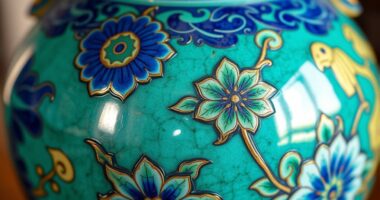Prism art draws inspiration from the science of light refraction and dispersion, showcasing how prisms split white light into vibrant rainbows. By understanding how light bends and separates into different colors, artists create stunning imagery that captures the natural beauty of rainbows. This technique brings luminous effects to artworks, both traditional and digital. If you want to explore how this fascinating interplay shapes artistic expression, there’s much more to discover.
Key Takeaways
- Prisms demonstrate light refraction, splitting white light into a spectrum, inspiring early rainbow imagery in art.
- Artists have historically used prism effects and color dispersion to create luminous, rainbow-inspired visual works.
- Techniques like glazing and layering mimic the dispersion of light, producing vibrant, rainbow-like effects in paintings.
- The scientific understanding of refraction influenced both traditional and modern artists in depicting light phenomena.
- Prism imagery expanded artistic exploration of natural wonder, symbolizing beauty, hope, and the interplay of light and color.

Have you ever wondered how artists capture the mesmerizing effects of light and color? It all begins with understanding the fascinating science behind how light interacts with objects, especially through a process called light refraction. When a beam of light passes through a prism, it bends and splits, revealing a vivid display of the color spectrum. This natural phenomenon has inspired countless artists to explore and incorporate these dazzling displays into their work, giving birth to the enchanting domain of rainbow imagery. By harnessing the principles of light refraction, artists can recreate the magic of a rainbow and evoke feelings of wonder and awe in their viewers.
When you look at a prism, you’re witnessing more than just a simple piece of glass; you’re observing a tool that reveals the hidden beauty within light itself. Light refraction occurs because different wavelengths of light bend at slightly different angles as they pass through a medium like glass. This bending separates the white light into its component colors—red, orange, yellow, green, blue, indigo, and violet—forming the familiar and breathtaking color spectrum. Artists who understand this process can emulate these effects in their work, using techniques that mimic the dispersion of light to produce shimmering, multi-hued visuals. The color spectrum isn’t just a scientific concept; it’s a palette of endless possibilities for creative expression.
A prism reveals light’s hidden colors, inspiring artists to craft luminous, rainbow-inspired masterpieces through the science of refraction.
Throughout history, artists have been fascinated by the interplay of light and color, drawing inspiration from the natural phenomena revealed by prisms. They’ve used techniques like glazing, layering, and blending to evoke the luminous quality of light refraction. In paintings, the subtle gradations of color can imitate the way light disperses, creating a sense of depth and movement. Modern digital artists also harness the principles of the color spectrum, using software to simulate the way light bends and splits, producing vibrant, rainbow-like displays that enthrall viewers. Understanding color dispersion helps artists craft more realistic and captivating representations of light effects, enriching their visual storytelling. By understanding how light refraction works, artists can craft images that seem to glow from within, mimicking the mesmerizing effect of a prism’s magic.
Ultimately, the science behind light refraction and the color spectrum provides artists with a powerful tool for transforming simple materials into vivid expressions of light and color. Whether through traditional painting or digital media, they capture the fleeting beauty of a rainbow, inviting others to see the world through a prism’s perspective. It’s a celebration of the natural wonder that sparks creativity and reminds us of the extraordinary phenomena happening all around us, waiting to be explored and celebrated in art.
Frequently Asked Questions
How Did Prism Art Influence Modern Digital Graphics?
Prism art influences modern digital graphics by shaping how you understand color theory and visual perception. It teaches you to see how light splits into various colors, inspiring digital artists to create vibrant, eye-catching designs. You use this knowledge to manipulate colors and improve visual clarity in your work, making digital images more dynamic and engaging. This foundational concept continues to drive innovation in digital graphics and visual communication today.
What Are the Primary Techniques Used in Creating Prism-Inspired Artworks?
Imagine the colors dancing like whispers of light—this is how you create prism-inspired artworks. You primarily use techniques like color blending, where hues seamlessly merge, and geometric fragmentation, breaking images into sharp, faceted shapes. These methods mimic the prism’s refraction, capturing its mesmerizing effect. By playing with light and structure, you craft pieces that evoke the dynamic, multi-dimensional beauty of a rainbow, inviting viewers into a luminous world of visual wonder.
Which Artists Pioneered the Use of Rainbow Imagery in Their Work?
You should explore how artists like Louis Comfort Tiffany and Wassily Kandinsky pioneered the use of rainbow imagery, blending vibrant colors through innovative techniques. They applied color theory to evoke emotion and deepen visual impact, showcasing artistic innovation that transformed modern art. By experimenting with light, color, and form, they helped establish rainbow imagery as a powerful expressive tool, inspiring countless artists to embrace bold, colorful compositions in their work.
How Does Prism Art Relate to Scientific Discoveries About Light?
Prism art relates to scientific discoveries about light through the principles of light refraction and spectral analysis. As you observe how a prism bends light, you see the spectrum of colors emerge, mirroring scientific experiments that reveal light’s composition. Artists harness this understanding to create vibrant, dynamic works that celebrate the beauty of light’s natural behavior, making science and art beautifully interconnected.
Are There Specific Cultural Movements Associated With Prism and Rainbow Art?
You’ll find that prism and rainbow art are linked to cultural movements like LGBTQ Pride and the Psychedelic Movement. These vibrant, colorful visuals symbolize diversity, unity, and altered perceptions, resonating deeply with these communities. The LGBTQ Pride movement uses rainbow imagery to promote inclusivity, while the Psychedelic Movement embraces vivid, kaleidoscopic art to explore consciousness. Both movements celebrate color as a symbol of identity, freedom, and expanded awareness.
Conclusion
So, as you see, prism art propelled the powerful parade of rainbow imagery, revealing a rich domain of radiant, resplendent colors. By blending brilliance with boundary-breaking ideas, it beckons you to believe in bold, beautiful boundaries beyond black and white. Embrace this vibrant vision, and let your creativity cascade like a colorful cascade of chromatic curiosity. Remember, the birth of rainbow imagery is a bold, beautiful beacon for boundless artistic brilliance.









